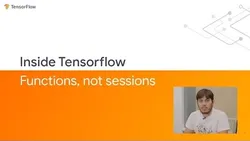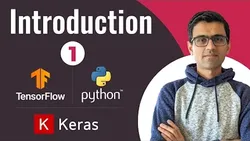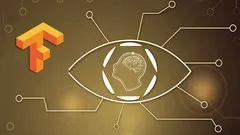
Inside TensorFlow: Functions not sessions 
TensorFlow is a powerful tool for machine learning, and this course explains the differences between using sessions and functions. It explains how variables are used, and how functions can be used to control the flow of data. It also provides a walkthrough of how to use functions to capture, process, and control data. ▼
ADVERTISEMENT
Course Feature
![]() Cost:
Cost:
Free
![]() Provider:
Provider:
Youtube
![]() Certificate:
Certificate:
Paid Certification
![]() Language:
Language:
English
![]() Start Date:
Start Date:
On-Demand
Course Overview
❗The content presented here is sourced directly from Youtube platform. For comprehensive course details, including enrollment information, simply click on the 'Go to class' link on our website.
Updated in [February 21st, 2023]
This course provides an introduction to TensorFlow functions and how they differ from sessions. It covers topics such as session vs runtime, session not run, partial run, TensorFlow functions, variables, the compromise, the solution, the downsides, walkthrough, photograph, capture, phonegraph, automatic control, calling functions, differentiating functions, concrete functions, code base, variable lifting, variable subclasses, variable capture scopes, stateless functions, lift to graph. Participants will gain an understanding of how to use TensorFlow functions and how to apply them to their own projects.
[Applications]
The application of this course is to help users understand the differences between TensorFlow sessions and functions, and how to use functions to create and manage variables. After completing this course, users should be able to use TensorFlow functions to create and manage variables, call functions, differentiate functions, create concrete functions, and lift variables to the graph. Additionally, users should be able to use variable lifting, variable subclasses, and variable capture scopes to create stateless functions.
[Career Paths]
1. Machine Learning Engineer: Machine learning engineers are responsible for developing and deploying machine learning models. They use a variety of tools and techniques to build, train, and deploy models. They also need to be able to interpret and explain the results of their models. The demand for machine learning engineers is growing rapidly as more companies are looking to leverage the power of machine learning to improve their products and services.
2. Data Scientist: Data scientists are responsible for analyzing large datasets to uncover patterns and insights. They use a variety of tools and techniques to extract, clean, and analyze data. They also need to be able to interpret and explain the results of their analysis. Data scientists are in high demand as companies look to leverage the power of data to improve their products and services.
3. Artificial Intelligence Engineer: Artificial intelligence engineers are responsible for developing and deploying AI-based systems. They use a variety of tools and techniques to build, train, and deploy AI-based systems. They also need to be able to interpret and explain the results of their systems. The demand for AI engineers is growing rapidly as more companies are looking to leverage the power of AI to improve their products and services.
4. Deep Learning Engineer: Deep learning engineers are responsible for developing and deploying deep learning models. They use a variety of tools and techniques to build, train, and deploy deep learning models. They also need to be able to interpret and explain the results of their models. The demand for deep learning engineers is growing rapidly as more companies are looking to leverage the power of deep learning to improve their products and services.
[Education Paths]
1. Computer Science Degree: A computer science degree is a great way to learn the fundamentals of programming and software development. It covers topics such as algorithms, data structures, computer architecture, operating systems, and software engineering. With the rise of artificial intelligence and machine learning, computer science degrees are becoming increasingly popular and in demand.
2. Artificial Intelligence Degree: An artificial intelligence degree focuses on the development of intelligent systems that can think and act like humans. It covers topics such as natural language processing, computer vision, robotics, and machine learning. With the increasing demand for AI-based solutions, an AI degree is becoming increasingly popular.
3. Data Science Degree: A data science degree focuses on the analysis and interpretation of large datasets. It covers topics such as data mining, machine learning, data visualization, and predictive analytics. With the increasing demand for data-driven solutions, a data science degree is becoming increasingly popular.
4. Machine Learning Degree: A machine learning degree focuses on the development of algorithms that can learn from data. It covers topics such as supervised and unsupervised learning, deep learning, reinforcement learning, and natural language processing. With the increasing demand for AI-based solutions, a machine learning degree is becoming increasingly popular.
Course Provider

Provider Youtube's Stats at AZClass
Discussion and Reviews
0.0 (Based on 0 reviews)
Explore Similar Online Courses

LumaFusion Tutorial: How To Edit Videos On iPhone iPad & Android!

iOS Development Course - Use Swift 5 and UIKit to Build a Netflix Clone

Deep Learning With Tensorflow 20 Keras and Python

Tensorflow on Googles Cloud Platform for Data Engineers

Deep Learning and Reinforcement Learning with Tensorflow

Tensorflow Deep Learning - Data Science in Python

Neural Networks with Tensorflow

TensorFlow Hub: Deep Learning Computer Vision and NLP

LEARNING PATH: TensorFlow: Computer Vision with TensorFlow

Hands-On Transfer Learning with TensorFlow 20

Human Tracking & Counting using TensorFlow & Deep Learning


Start your review of Inside TensorFlow: Functions not sessions